Universal Precautions Is Best Described as :
Universal Precautions rev 9 2010 1. Universal precautions refers to the practice in medicine of avoiding contact with patients bodily fluids by means of the wearing of nonporous articles such.
According to the concept of universal precautions all human blood and certain human body fluids are treated as if known to be infectious for HIV hepatitis B and other blood-borne pathogens 29 CFR 19101030 b definitions.
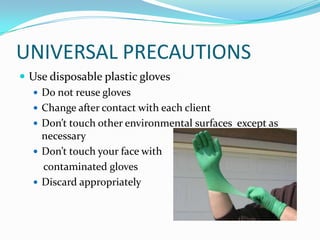
. The concept of Universal Precautions is taught in rst aid classes across the g lobe requir ing people to treat al l b lood and bodi ly wa s t e as co n ta m i nat e d w it h a vi r u s suc h as. Uses pressure and steam to sterilize objects and instruments. Universal precauti ons refer to the practice in medicine where healthcare agents are expected to protect themselves with materials like gloves and face shields to prevent contamination by pathogens.
Standard Precautions Hand Hygiene. An infection control practice where all human blood or OPIM are treated as if they were infectious for HIV HBV HCV and other bloodborne pathogens. The statement that best describes the term universal precautions is.
An enhanced assessment and quality improvement planning tool including a link to a SurveyMonkey template for conducting practice assessments electronically. Universal precautions were introduced by the Centers for Disease Control CDC in 1985 mostly in response to the human immunodeficiency virus HIV epidemic123 Universal precautions are a standard set of guidelines to prevent the transmission of bloodborne pathogens from. OPIM is defined by the Occupational Safety and Health Administration OSHA as.
Is a really tasty refreshing beverage. Universal precautions up originally recommended by the cdc in the 1980s was introduced as an approach to infection control to protect workers from hiv hbv and other bloodborne pathogens in human blood and certain other body fluids regardless of a patients infection status. Use standard precautions in providing for all.
Absolute risk is low. Is an agent that is applied directly to the skin with the purpose of killing pathogens. Standard Precautions are used for all patient care.
Changing gloves between. Universal precautions are guidelines regarding to infection control. Universal precautions a set of behaviors designed by the CDC to minimize the spread of infectious disease the purpose is to disruptprevent the invasion of bacteria or viruses through the use of appropriate barriers.
Ammonia is a compound of nitrogen and hydrogen with the formula NH 3A stable binary hydride and the simplest. A lab researcher would be certain to note 1. These entail avoiding contact with an individuals blood or bodily fluids under any circumstance.
Standard Precautions Previously Known as Universal Precautions There is a potential for all blood and body fluids to transmit viruses Therefore. Using disposable gloves and other protective barriers while examining all patients and while handling needles scalpels. Its a method of control to protect employees from exposure to all human blood and other.
Which of the following statements best defines universal precautions. Hand hygiene is the most important measure to prevent the spread of infections among patients and DHCP. Is a strong chemical such as bleach that destroys pathogens on objects not on skin.
2 up is an approach to infection control in which all human blood. Formerly called universal precautions is the best way to prevent contact with infected blood or other potentially infectious materials. New resources for assessing written materials.
The AHRQ Health Literacy Universal Precautions Toolkit 2 nd edition includes such features as. Three Universal Precautions that fall under the category of Body Substance Isolation are. Universal precautions are intended to prevent parenteral mucous membrane and nonintact skin exposures of health-care workers to bloodborne pathogens.
Size and shape 2. Personal protective equipment PPE refers to wearable equipment that is designed to. Any observable motility 3.
Universal precautions is an approach to infection control. All patients must be treated as if they are infectious. Wearing nitrile or latex gloves Wearing protective eyewear Wearing a.
Universal precautions means any and all samples whether known or unknown are to be treated as potentially hazardous or pathogenic materials. Universal precautions are a set of protective measures one can take to prevent transmission of communicable diseases. These guidelines are used to safeguard workers from coming in contact with diseases that are spread by blood and certain body fluids.
Universal precautions means any and all samples whether known or unknown are to be treated as potentially hazardous or pathogenic materials. Clean the area as described below or per your employers policies report the incident and get medical care. Question 2 What would a researcher be certain to note while analyzing a microbial sample.
Theyre based on a risk assessment and make use of common sense practices and personal protective equipment use that protect healthcare providers from infection and prevent the spread of infection from patient to patient. Washing hands and other skin surfaces that are contaminated with blood or body fluids immediately after a procedure or. Universal Precautions Are Best Described as Which of the Following By Ra_Catalina594 22 Apr 2022 Post a Comment The first fighting took place several months after the landing of the First Fleet in January 1788 and the last clashes.
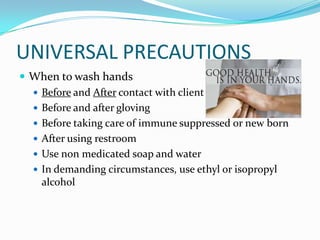
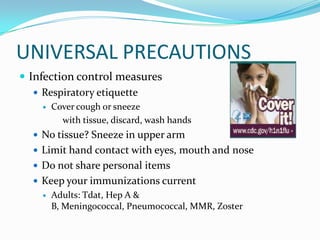
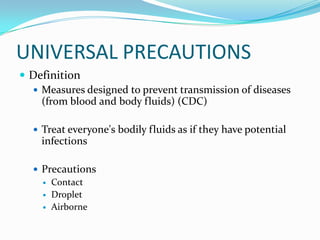
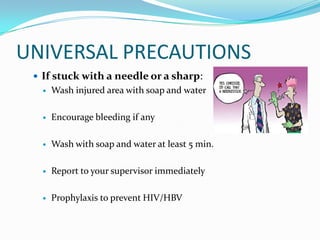
Comments
Post a Comment